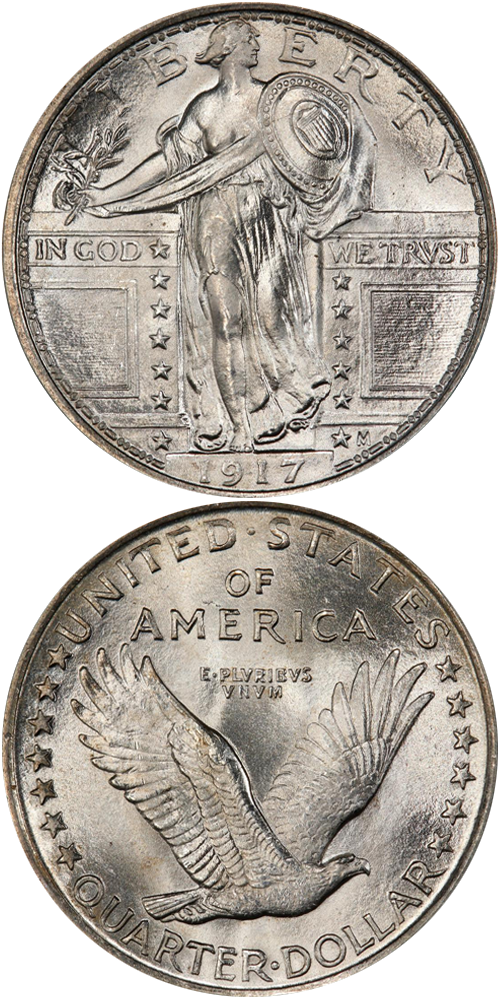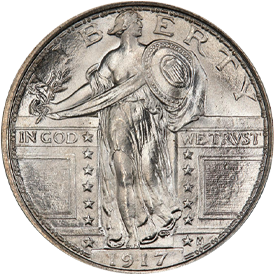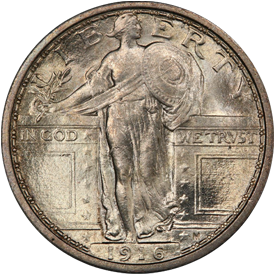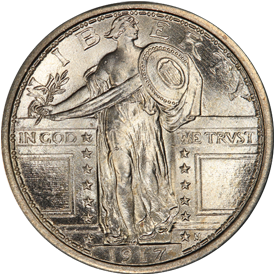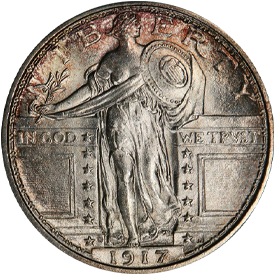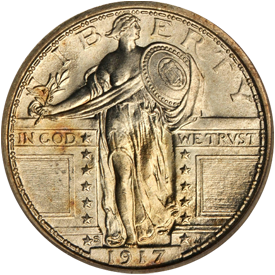Designed by: Hermon A. MacNeil
Issue Dates: 1916-1917
Composition: 90% silver, 10% copper
Diameter: 23.4 mm
Weight: 6.25 grams (96.45 grains)
Edge: Reeded
Business Strike Mintage: 12,253,200
Proof Mintage: None
In 1916 Hermon A. MacNeil, a well-known sculptor, produced a new design for the quarter dollar, replacing the familiar Barber design which had been employed since 1892. The obverse depicts Miss Liberty standing in a gateway, her right breast exposed, wearing a gown, holding a branch in her right hand and a shield in her left. LIBERTY is in an arc above, while IN GOD WE TRUST is lettered on the wall or parapet to each side of where she stands. The date is on a pedestal beneath her feet. The reverse shows an eagle flying to the right, with UNITED STATES OF AMERICA and E PLURIBUS UNUM above, with QUARTER DOLLAR below. Seven stars are to the left and six to the right. 52,000 were minted in 1916, followed by generous mintage of over 10,000,000 at the three mints in 1917. Complaints arose concerning the partial nudity of Miss Liberty, and because of this the design was soon changed.
While examples of the 1916 date are rare, the type set collector desiring a Standing Liberty quarter of 1917 will have no difficulty in acquiring one from any desired grade from Good through AU. Uncirculated pieces are fairly scarce, while superb Uncirculated coins are very elusive. Unlike their later counterparts, Type I quarters are usually sharply struck at Miss Liberty's head and on the shield. Most Uncirculated pieces possess full details.
Full Head
Herman MacNeil’s full figure of Liberty striding forward with a shield and olive branch is an iconic design, and one of the most beautiful and admired seen on U.S. coinage. Unfortunately, the fine details of Liberty’s head were prone to weakness, and sometimes appear flat or even “dished” in some cases. Because this aspect of the design added a great deal of beauty to the coin, it was recognized quickly by collectors, and by the early 1950s, small premiums were being paid by collectors for Standing Liberty Quarters with fully-struck head details.
When the two major grading services opened, “FH” or Full Head were added to the grade of Standing Liberty Quarters that met the qualifications. Note that the three leaves on her head, as well as the complete hairline behind her eye must show. So important is this attribute that coins without a full head are sometimes sold and advertised as 50% or up to 95% Full Head.

Further Reading
The first year of issue of the Standing Liberty quarter, 1916, saw a mintage of 52,000 examples. From the outset the variety attracted wide attention. First, the public saved examples due to the novelty of the motif and the controversy surrounding the nudity. Further, numismatists immediately recognized that only a small quantity left the coining presses, so examples sold for a premium from the very time of issue. Henry Chapman, for one, scurried about to lay in an inventory of these quarters. As a result, while the 1916 Standing Liberty quarter is rare as a date, in Uncirculated condition at least a few thousand exist. I once had the pleasure of seeing a roll of 40 pieces owned by a Pennsylvania numismatist. This was years ago, and undoubtedly the individual pieces are now scattered in as many collections.
The low mintage of the 1916, its necessity to complete the series, its status as the first year of issue, and other factors have combined to make the piece a highly prized rarity. Today, the offering of an Uncirculated example is typically heralded with appropriate fanfare. And, the issue deserves it.
On the majority of Standing Liberty quarters the dies were spaced slightly too far apart to bring up all of the design details to full sharpness. Often the very high details on the head of Miss Liberty are indistinct. Those pieces which have distinctly struck features in this area are known as "full head" quarters (abbreviated FH) and bring a significant premium.
The occurrence of sharply struck, full head pieces varies from year to year. In general, issues of the first year, 1916, usually have full or nearly full heads. 1917 Type I quarters of all three mints usually have full heads as well.
